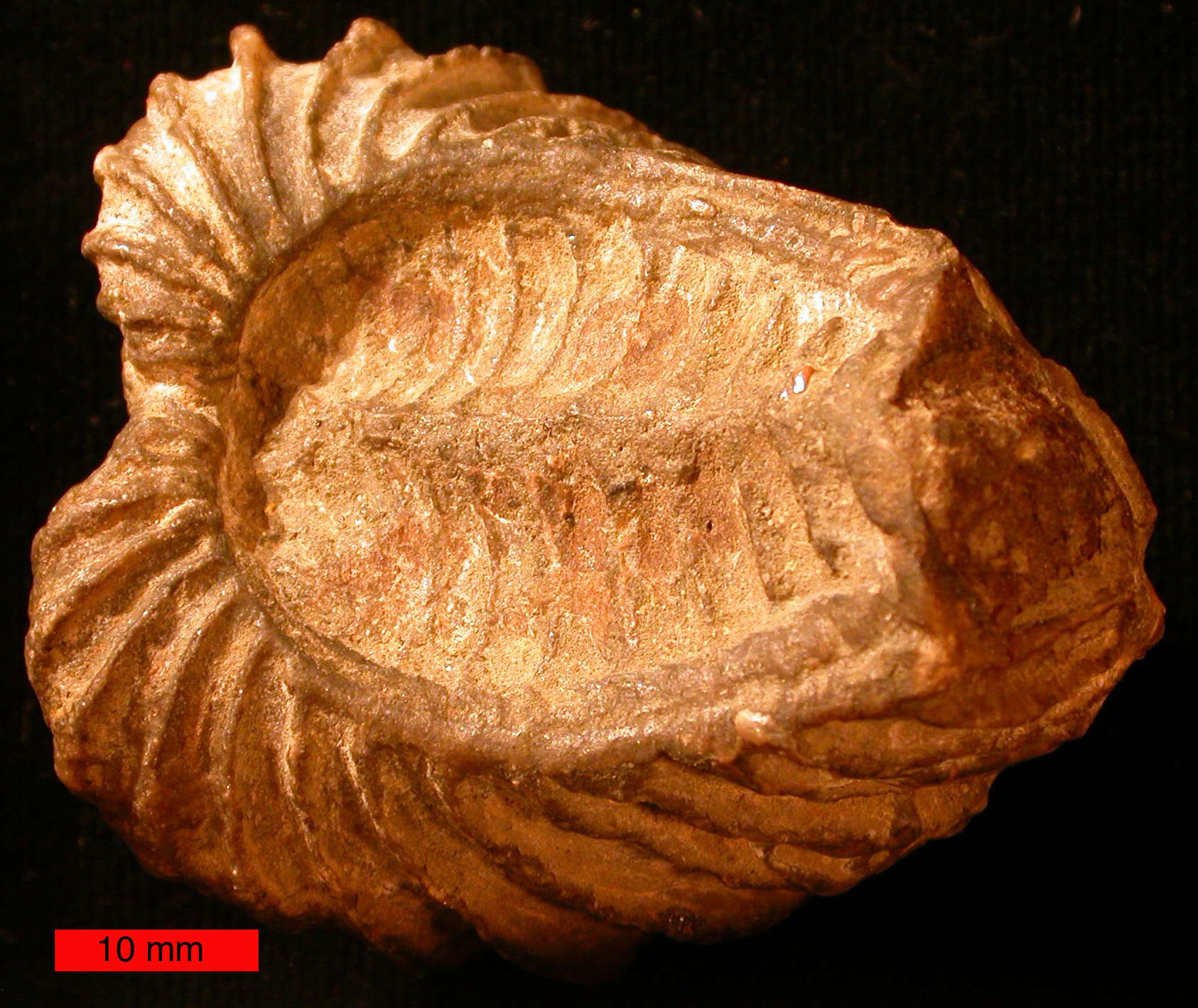- Trigoniidae
image caption = "Trigonia" sp. (Cretaceous ) near Austin, Texas. Scale bar is 10 mm.
regnum =Animal ia
phylum =Mollusca
classis =Bivalvia
subclassis =Palaeoheterodonta
ordo =Trigonioida
superfamilia =Trigoniacea
familia = Trigoniidae
familia_authority = Lamarck
subdivision_ranks = Common Genera
subdivision =
*"Trigonia"
*"Myophorella"
*"Laevitrigonia"
*"Orthotrigonia"The Trigoniidae represent a large and morphologically interesting Family of highly ornamented non-siphonate
bivalves . They originated from theMyophoriidae in theTriassic and underwent an explosion of diversity in theJurassic , reaching an acme in theCretaceous , although most genera became extinct at the end of this period. The most striking feature of the Trigoniidae, which has attracted attention for centuries, is their striking external ornament. This is usually present asribs orcostae or rows of aligned tubercles. Although they were abundant in theMesozoic era, they are today represented by only one livinggenus , "Neotrigonia", which inhabits waters off the coast of southAustralia .Neotrigonia - the discovery of a living genus
Before the beginning of the nineteenth century, no trigoniid had been described from rocks younger than the Cretaceous Period. In 1802, however,
Francois Peron discovered a living species in waters off the coast ofTasmania .Lamarck named it "Trigonia margaritacea" in 1804 with Cossmann renaming the genus "Neotrigonia" in 1912. Today, five living species have been identified, and are all found off the coast of Australia. "Neotrigonia" probably evolved from "Eotrigonia" (Eocene toMiocene ) in the Miocene.Previous research on the Trigoniidae
Because of their large size and pronounced ornament, trigoniid bivalves have long attracted interest.
Jean Guillaume Bruguiere was the first person to describe an example of "Trigonia" in 1789.Lamarck later figured specimens from the Oxfordian ofFrance . InEngland thephysician James Parkinson (the discoverer ofParkinson's disease ) described examples of "Trigonia" and "Myophorella". Later,James Sowerby andJames De Carle Sowerby began to catalogue British examples in earnest.Etheldred Benett added severalUpper Jurassic species , although her work was not primarily recognised due to the academic status of women at that time.In Europe the great
Louis Agassiz published, in 1840, a large volume entitled "Memoire sur les Trigonies" which recognised the large variation encountered within the family, dividing it into eight sections, which was a precursor to the generic classification that occurred some fifty years later. Other notable workers that described and figured trigoniids includeFriedrich August von Quenstedt ,Alcide d'Orbigny andGeorg August Goldfuss .The major worker on the Trigoniidae in the nineteenth century was
John Lycett , a physician fromGloucestershire who published a significant text entitled "A Monograph of British Fossil Trigoniae".Later research - the twentieth century
Work on the Trigoniidae has generally been sparse in the twentieth century and has mainly concentrated upon the development towards a workable
taxonomy . Today, knowledge is sufficient to divide the Family into fiveSubfamilies (see below), which together contain more than sixteen genera, the most abundant being "Trigonia", "Myophorella", "Laevitrigonia", and "Orthotrigonia".Higher level taxonomy
*Family Trigoniidae
**Subfamily Trigoniinae
***"Trigonia"
***"Agonisca"
***"Maoritrigonia"
***"Praegonia"
***"Minetrigonia"
***??"Pseudomyophorella"**Subfamily Prosogyrotrigoniinae
***"Prosogyrotrigonia"
***"Prorotrigonia"**Subfamily Psilotrogoniinae
***"Psilotrigonia"**Subfamily Myophorellinae
***"Frenguilellella"
***"Jaworskiella"
***"Myophorella"
***"Vaugonia"
***"Orthotrigonia"
***"Scaphotrigonia"**Subfamily Laevitrigoniinae
***"Laevitrigonia"
***??"Liotrigonia"Family characteristics - trigoniid hinge
Members of the Trigoniidae are identified by the large and complex
dentition that joins the two valves together and allows articulation. Theteeth and supporting area can take up almost a third of the volume of the shell. Thehinge structure is amongst the most complex of all bivalves, namely that the teeth are numerous and ridge-like with strong transverse striations. It is these striations which distinguishes the Trigoniidae from the more primitive Myophoriidae. The Trigoniidae almost certainly evolved by amonophyletic modification of a Triassic myophoriid, with three genera appearing in the Middle Triassic.Commonly found genera
Trigoniids are commonly found in both
limestone ,mudstone andsandstone in Jurassic and Cretaceous rocks all over the world. In Britain, examples are numerous in theUpper Jurassic rocks of theDorset coast, particularly around the village ofOsmington Mills . Other Jurassic rocks that yield specimens include theCornbrash inYorkshire and theMiddle Jurassic sequence in theCotswolds , particularly aroundCleeve Hill , nearCheltenham ."Trigonia"
The genus "Trigonia" is the most readily identifiable member of the family, having a series of strong ribs or costae along the
anterior part of the shell exterior. They are the first representatives of the family to appear in theMiddle Triassic (Anisian ) ofChile andNew Zealand . The first European examples ("Trigonia costata" Parkinson) turn up in the Lower Jurassic (Toarcian ) ofSherborne , Dorset andGundershofen ,Switzerland .Source: Francis, A.O. 2000. "The Palaeobiology of the European Jurassic Trigoniidae". Ph.D. thesis,
University of Birmingham , 323pp.
Wikimedia Foundation. 2010.

